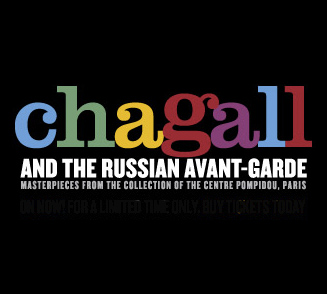 Some time in the 1950s, Pablo Picasso apparently said: “When Matisse dies, Chagall will be the only painter left who understands what colour really is.”
Some time in the 1950s, Pablo Picasso apparently said: “When Matisse dies, Chagall will be the only painter left who understands what colour really is.”
Picasso’s enthusiastic appreciation of Russian-French artist Marc Chagall’s colourful whimsy is widely shared, and Chagall’s work is well-known for its unique and accessible style. Chagall is less known, however, for his extensive dream-like depictions of the period surrounding the 1917 Russian Revolution. And that’s one reason why the Art Gallery of Ontario’s new Chagall and the Russian Avant-garde exhibit, which situates Chagall’s oeuvre within the political and social climate of that time, does a stellar job of unveiling a less explored and surprising angle to the artist’s work.
The exhibition, organized by Paris’ Centre Pompidou, features 118 works of painting, sculpture, paper, photography and film by Chagall and other prominent Russian modernists, including Wassily Kandinsky, Kasimir Malevich, Natalia Goncharova, Sonia Delaunay, and Vladimir Tatlin.
Chagall and the Russian Avant-garde traces the development of Chagall’s artistic vision and the forces which drove it: his strong connection to his native Vitebsk and his Jewish heritage, his interaction with his contemporaries, and his reactions to the political and social upheavals in early 20th century Russian society.
The thrilling contextualization of Chagall’s works within the larger political and social landscape of his time was a goal clearly envisioned by Angela Lampe, curator of historical collections at the Centre Pompidou. “Chagall himself always wanted this dialogue to happen, but there were limitations in Russia because he was a Jew,” Lampe has said. “So we are fulfilling a wish of his with this show.”
One of the most striking aspects of the exhibit as a whole is that it captures the unique utopian vision of social equality and strength associated with the newly-created Soviet Union that was likely observed by Chagall and his contemporaries. That vision is present in the eager-looking youth and bright red Cyrillic alphabet slogans featured in works like Alexander Rodchenko’s “Pioneer with a Trumpet” (1930) and El Lissitzky’s “Poster for the Russian Exhibition at the Decorative Arts Museum of Zurich” (1929). The same idealism and enthusiastic productivity is captured in Dziga Vertov’s infamous “Man with a Movie Camera” (1929) — still touted as one of the most innovative silent documentaries of the twentieth century — with its split screen shots of streetcars, trains, and hordes of rushed Soviet commuters.
What: Chagall and the Russian Avant-garde: Masterpieces from the Collection of the Centre Pompidou, Paris
Where: Art Gallery of Ontario
When: October 18, 2011 to January 15, 2012
Tickets: Visit the AGO website

